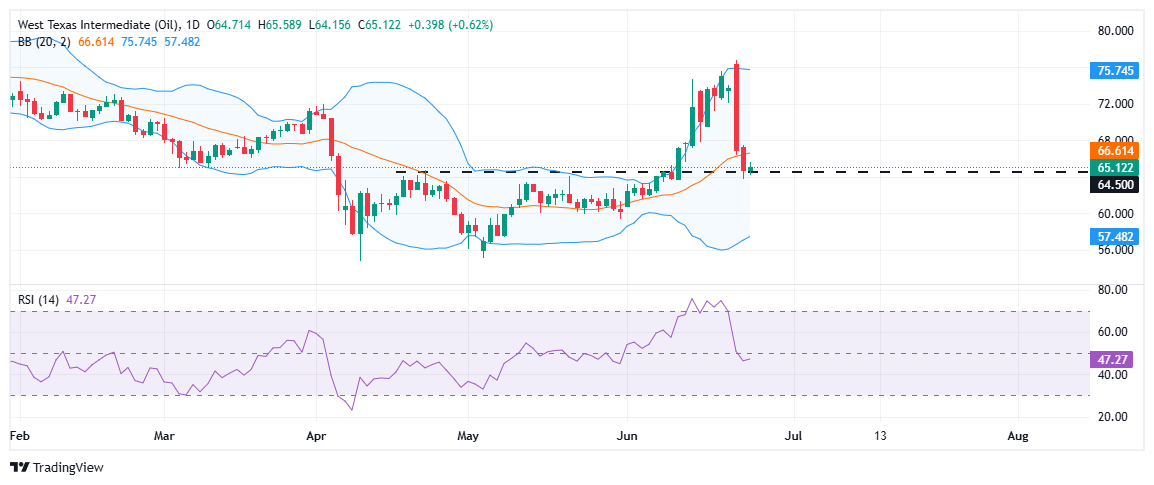WTI snaps losing streak as US crude stockpiles fall
- WTI Crude Oil rebounds 0.75% on Wednesday, trading near $65.20 after a steep two-day slide.
- EIA reports a larger-than-expected 5.836 million-barrel drop in US crude inventories.
- RSI slips to 47, WTI holds above key support at $64.50, resistance at $66.60.
West Texas Intermediate (WTI) Crude Oil reverses course during the American session on Wednesday, snapping a two-day losing streak after spending much of the day drifting lower. The move came as traders digested easing geopolitical tensions between Iran-Israel and fresh EIA data showing a notable decline in US crude stockpiles.
At the time of writing, WTI is trading near $65.20, recovering around 0.75% on the day. This comes after a brutal two-day slide of nearly 13%, which was the sharpest two-day decline since 2022.
A major factor supporting the rebound in Oil prices is the larger-than-expected drawdown in US crude and fuel inventories. The latest data from the Energy Information Administration (EIA) showed a decline of 5.836 million barrels for the week ending June 21, far exceeding expectations for a modest 0.6 million-barrel drop. This marks the fifth straight weekly fall in stockpiles, reinforcing signs of tightening supply conditions amid steady summer demand.
Geopolitical tensions, another dominant theme for Oil traders, took a backseat as a tentative ceasefire between Israel and Iran showed signs of holding after a rocky start. While early violations by both sides had raised doubts, global markets are cautiously embracing a “risk-on” mood, with equities firming and oil volatility easing.
However, the ceasefire remains fragile. While US President Donald Trump claimed that recent US missile strikes had "totally obliterated" Iran’s nuclear facilities, intelligence report suggest the damage only delayed Tehran’s nuclear program by a few months. US President Donald Trump has since reiterated that Washington remains ready to act again should Tehran resume its nuclear ambitions.
This complex geopolitical backdrop continues to influence market sentiment. While some of the geopolitical risk premium has been unwound, any renewed flare-up could rapidly shift momentum and reignite bullish pressure on Oil.

After tumbling nearly 13% over the past two sessions, WTI Crude has found interim support at $64.50 – a key horizontal level that acted as resistance since mid April. The price is attempting to stabilize just above this zone, currently trading near $65.20.
The Relative Strength Index (RSI) has slipped to 47, reflecting weakening momentum without yet signaling oversold conditions. Price is hovering near the middle Bollinger Band—the 20-day SMA at $66.60—which now acts as key resistance.
A break below $64.50 could expose downside toward $62.00 and $60.00. On the flip side, reclaiming $66.60 would open the door to $68.00 and potentially $70.00. For now, WTI remains range-bound, with traders eyeing upcoming US GDP and PCE data for fresh direction.
WTI Oil FAQs
WTI Oil is a type of Crude Oil sold on international markets. The WTI stands for West Texas Intermediate, one of three major types including Brent and Dubai Crude. WTI is also referred to as “light” and “sweet” because of its relatively low gravity and sulfur content respectively. It is considered a high quality Oil that is easily refined. It is sourced in the United States and distributed via the Cushing hub, which is considered “The Pipeline Crossroads of the World”. It is a benchmark for the Oil market and WTI price is frequently quoted in the media.
Like all assets, supply and demand are the key drivers of WTI Oil price. As such, global growth can be a driver of increased demand and vice versa for weak global growth. Political instability, wars, and sanctions can disrupt supply and impact prices. The decisions of OPEC, a group of major Oil-producing countries, is another key driver of price. The value of the US Dollar influences the price of WTI Crude Oil, since Oil is predominantly traded in US Dollars, thus a weaker US Dollar can make Oil more affordable and vice versa.
The weekly Oil inventory reports published by the American Petroleum Institute (API) and the Energy Information Agency (EIA) impact the price of WTI Oil. Changes in inventories reflect fluctuating supply and demand. If the data shows a drop in inventories it can indicate increased demand, pushing up Oil price. Higher inventories can reflect increased supply, pushing down prices. API’s report is published every Tuesday and EIA’s the day after. Their results are usually similar, falling within 1% of each other 75% of the time. The EIA data is considered more reliable, since it is a government agency.
OPEC (Organization of the Petroleum Exporting Countries) is a group of 12 Oil-producing nations who collectively decide production quotas for member countries at twice-yearly meetings. Their decisions often impact WTI Oil prices. When OPEC decides to lower quotas, it can tighten supply, pushing up Oil prices. When OPEC increases production, it has the opposite effect. OPEC+ refers to an expanded group that includes ten extra non-OPEC members, the most notable of which is Russia.


